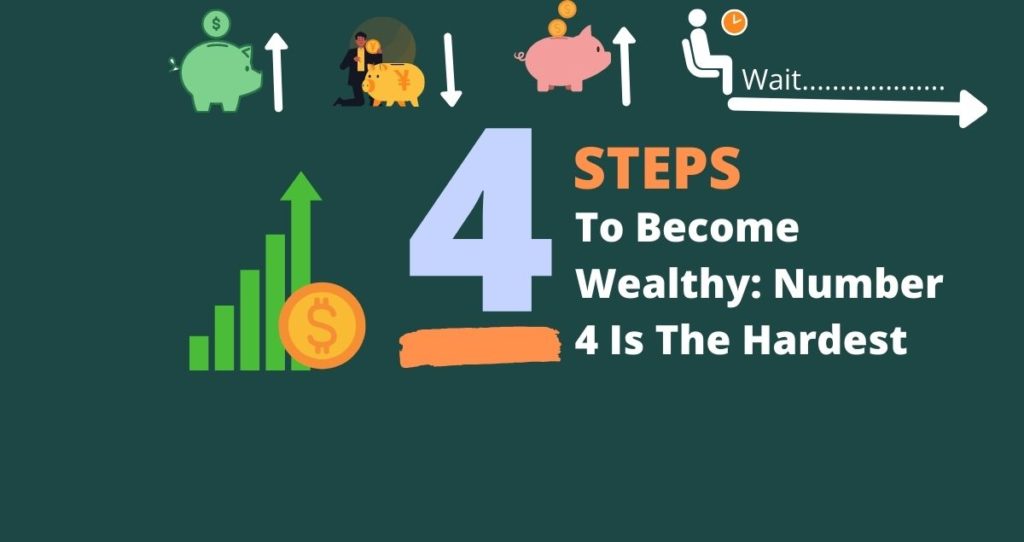When it comes to investing, poverty can be a limiting factor for millions of people. This is because poor people usually don’t have extra cash to invest due to living paycheck-to-paycheck. The good news is that investing is not only for the rich. No matter how much you make, you can still invest and build wealth just like the rich do. Due to limited financial means, however, your investment strategies and return on investment(ROI) might not be the same as wealthy people. There are investment strategies for poor people you can implement and start earning passive income no matter how much you start with.
If you are poor and are looking for ways to invest money, I have put together a list of different ways to invest when you are low on cash for maximum profit. Whether you want to make extra cash to supplement your income, want to boost your net worth, or simply get out of poverty, this article is for you.
Without further ado, here are 11 ways to invest when you are poor for maximum return.
1. Pay off your debt
If you want to invest when you are poor, your first investment will not be putting money in stocks, real estate, or bonds. Getting your finances in order will be your foremost important investment strategy and that starts with paying off your debts.
It’s no secret that debt can weigh heavily on your finances and limit your ability to save and invest. By focusing on paying off high-interest debts first, such as credit card balances or personal loans, you can save yourself from accruing unnecessary interest expenses. You don’t have to pay off your debts in a lump sum as your financial means are limited. However, by allocating a portion of your income each month towards debt repayment, you can gradually lower your outstanding balance and regain control of your financial situation.
Example of how paying off your debts is a great investment strategy when you are poor
Let’s assume that you have $1,000 cash and $1,000 in credit card balance. The question is: should you invest that $1,000 or should you use it to pay off your credit card balance? If you choose to invest that money in stocks, for example, you can make 10% ROI per year which is the historical return for the S&P 500, according to the S&P 500 data. This will earn you $100. At the same time, your credit card balance will cost you $244.6 at 24.6% which is the average APR for new credit card accounts, according to LendingTree.
What this means is that you are losing $244.6 on credit card interest charges to make $100 in stocks. In other words, you are losing $144.6 per year by investing the money in stock instead of paying off your debts. It is also important to mention that no investment can give you a 24% consistent return. That is why paying off your debts is the best way to invest when you are poor.
Technically, the interest you are not paying on debts is like earnings. The best way to pay off your debts as a strategy to invest when you are poor is to organize all your debts from small to large and pay them in that order. This strategy is known as Debt Snowball. You can also use the Debt Avalanche strategy where you organize your debts from the highest interest rate to the lowest and pay them in that order. The latter strategy requires a full commitment to paying off your debts and might take a while to see a significant impact on your debts.
You might like: 6 effective ways to pay off credit card debt
2. Focus on low-risk investments
Investing when you are poor means that you don’t have a lot of disposable cash, and therefore, every dollar counts. Unlike financially independent people who can afford to lose money, poor people do not have that kind of cash. If you have a few hundred dollars to invest, you cannot afford to lose that money. Losing a few hundred dollars could mean an end to your portfolio. That is why the best way to invest when you are poor is to minimize your risk as much as possible by buying low-risk investments.
So, how can you invest when you are poor and manage risk at the same time?
Here are strategies to invest when you are poor by focusing on low-risk investments.
1. Keep your money in low-risk accounts and assets
Focus on investment investments with low risk. For example, instead of putting your money in stocks, you can put it in high-yield deposit accounts such as CD accounts and high-yield savings accounts. With these accounts, you can easily earn 5% APY. What makes these accounts best for people with limited financial means is that your money will be insured by FDIC up to $250,000 per institution and per account category, according to the Federal Deposit Insurance Corporation(FDIC). Even if your ROI from deposit accounts will be lower, the protection of your funds is essential when you are getting started with investing.
2. Explore micro-investing platforms
Micro-investing has gained popularity in recent years, especially among younger investors who may not have a large sum of money to invest upfront. These platforms offer a simple and accessible way to enter the world of investing, even if you only have a few dollars to spare each month which makes them perfect investment options when you are poor.
With just a few taps on your smartphone, you can start investing in a range of assets such as stocks, bonds, and exchange-traded funds (ETFs). These apps and platforms are designed to be user-friendly and intuitive, making it easy for you to get started, regardless of your financial knowledge or experience.
Platforms like Robinhood, Acorns, Stash, and M1 Finance can be your starting point. These platforms allow you to invest small amounts of money, often as little as a few dollars, and you can diversify your portfolio across different assets. If you are low on cash, this strategy will allow you to get started investing without large upfront cash and learn the ropes of investing. Additionally, you might be able to invest commission-free when you buy and sell certain assets such as stocks.
3. Take advantage of retirement savings
Another effective strategy to invest when you are poor is to take advantage of employer-sponsored retirement plans such as 401(k) plans. These plans offer a variety of benefits including tax advantages and the potential for employer-matching contributions. By participating in a 401(k) plan, you can allocate a portion of your pre-tax income towards retirement and pay no tax on it until you are taking distributions during retirement.
You can also invest as little as you can afford which is another benefit of retirement contributions especially when you are low on cash. Another option is to open an IRA with your favorite brokerage firm and start investing based on what you can afford. You can contribute up to $22,500 in 2023 and $23,000 in 2024 or $30,000 if you are 50 or older in your 401(k). For IRA, you can contribute up to $6,500 or $7,500 if you are 50 or older.
You might also like: How to invest without losing money: Investing guide for newbies
3. Start small and early
One of the most powerful strategies to invest when you are poor is to start small and early. While it may seem daunting to invest with limited funds, the key is to start taking steps toward your financial future as soon as possible. Starting small allows you to dip your toes into the investing world without risking too much and gives you valuable experience to build upon.
By starting early, you open up the opportunity for compounding to work in your favor. Even if you have $50 to start with, as long as you make a regular contribution to the account and reinvest your interests and dividends, your account will grow. For example, $50 invested at 7% will earn you $3.5. This return might not be a lot, but it is better than nothing. So, if you are poor and want to invest, the best thing you can do is to get started.
4. Open a high-yield savings account
In the previous paragraph, I discussed high-yield savings accounts briefly. In this section, I will go a little deeper.
A high-yield savings account is exactly what it sounds like – a savings account that yields a higher interest rate compared to traditional savings accounts. These accounts are often offered by online banks and similar financial institutions. The increased interest rate helps your savings grow faster, ensuring that you maximize the potential of every dollar you save.
One of the key benefits of opening a high-yield savings account is the ability to earn compound interest. Unlike a regular savings account, where you earn interest on the amount of money you deposit, a high-yield savings account allows you to earn interest not only on your initial deposit but also on the interest it earns over time. This compounding effect can significantly boost your savings over the long run.
Additionally, high-yield savings accounts often come with no monthly maintenance fees or minimum balance requirements. This means that you can start building your savings without worrying about unnecessary costs that can potentially eat away at your funds. Furthermore, most high-yield savings accounts offer easy accessibility to your money when you can withdraw and make transfers up to six times a month. This makes savings accounts a reliable and convenient option for both short-term and long-term financial goals.
5. Consider Peer-to-Peer lending
Have you ever heard of peer-to-peer lending? This popular form of investing can earn you a considerable amount of return and you don’t need thousands of dollars to get started. Peer-to-peer lending is exactly what it sounds like. In simple terms, P2P lending is a form of investing conducted through online platforms that connects borrowers and lenders. All you have to do is create an account on one of the best peer-to-peer lending websites and start lending money to different people.
Peer-to-peer lending is great when you want to invest without a lot of cash as you don’t need too much money to get started. Additionally, peer-to-peer lending offers a unique opportunity to diversify your investments which is essential for your success. Instead of solely relying on the stock market or real estate, P2P lending allows you to tap into different investments.
Related: 7 best peer-to-peer lending websites to make extra cash
6. Use a robo-adviser
Investing when you are poor is always challenging due to limited resources. One of the costs you will encounter is the cost of financial advisers and portfolio management. If you are low on cash, however, these costs can eat into your profits and make it harder to grow your portfolio.
To avoid some of these costs, you can use a robo-adviser. These are companies that offer financial services such as investment advice and portfolio management at a fraction of the cost. To minimize these costs, most of these services are provided by highly advanced computer software with little human intervention. So, if you are getting started with investing and you are poor, using a robo-advisor might be your best shot.
7. Create an emergency fund
One of the most underrated investing strategies for poor people is creating an emergency fund. While it may not seem directly related to investing, having an emergency fund is a crucial step in preparing for any financial endeavor. By setting aside a portion of your income for unexpected expenses, you can handle any financial setbacks that may occur, without derailing your investment plans.
The lack of an emergency fund can spell disaster during difficult times.
Life is unpredictable, and unexpected expenses can arise at any time. It could be a sudden medical bill, a car repair, or a job loss. Without an emergency fund, you may find yourself digging into your investment funds or worse, accumulating debt to cover these unforeseen costs. This puts your current investments at risk and may hinder your ability to take advantage of future investment opportunities.
How to create an emergency fund?
The best way to create an emergency fund is to start small and be consistent. Set a specific amount or percentage of your income to save each month, and stick to it. Treat it as a non-negotiable expense, just like paying your bills or rent. Over time, these consistent contributions will add up and provide a safety net to fall back on when unexpected expenses arise.
How much to save for emergencies?
Emergency funds vary from one person to another due to different lifestyles. While there is no exact amount you should save for your emergencies, you should save between 3 to 6 months of expenses. For example, if your monthly expenses are $2,000, you should save between $6,000 to $12,000 for emergencies.
Related: Should you invest your emergency fund for better returns?
8. Look for investment opportunities in real estate
Real estate investing is one of those sectors many people stay away from due to the lack of capital. Just like everyone else, you might be thinking that you cannot invest in real estate when you are poor. The truth is that you don’t need that much money to invest in real estate. Yes, some real estate investments require a lot of cash. But there are also a few niches where you don’t need too much capital to start investing.
Without a lot of cash to spare, the best way to get started with real estate is to buy real estate investment trusts(REITs). With this option, you don’t own a physical property. Instead, you own shares of real estate companies just like regular stocks.
You can also invest in rental properties which is an effective way for millions of people to enter real estate. If you are poor, house hacking will be your best option. With house hacking, you buy a multi-unit property, live in one unit, and lease the others. With this setup, tenants cover all or some of your monthly mortgage payments. For example, you can buy a duplex, live in one unit, and lease the other unit.
This strategy will help you earn a steady stream of income which you can use to acquire more properties or buy assets that generate income.
You might also like: How much home can I afford?
9. Focus on long-term
Investing in long-term investments is a critical aspect of any successful investment strategy. While it can be tempting to seek quick returns or chase after the latest trends, a long-term perspective is essential for building sustainable wealth and maximizing financial gains.
As an investor, your main goal is to maximize return on investment. The only way to achieve this goal is to let your money stay invested for a long time and let compound interest do its thing. That is compound interest allows you to earn interest on interest which is essential in growing your net work fast with little to no work.
Additionally, investing your money in long-term assets gives you peace of mind during recessions. Recessions come and go and those who lose money are usually those who try to beat the fundamentally impossible market.
10. Automate your investments
Another strategy to invest money when you are poor is to automate your investments. Automating your investments can be a game-changer as it keeps you on your toes and helps you maintain consistency. All you have to do is set up automatic transfers from your checking account or paycheck into your investment accounts every month. This strategy helps you eliminate the temptation to spend money especially when you are low on cash. For example, you can have 5% moved into your IRA every month without even knowing it.
11. Educate yourself: Learn the basics of investing
The last and probably the most important thing you must do to invest when you are poor is to learn about investing.
Why is education so important in the world of investing? Well, think of it this way: if you were about to go for a long trip, you wouldn’t jump in the car without a map or GPS, right? Investing also works the same way. That is investing without understanding the fundamentals is like navigating uncharted territory blindly. In other words, it is gambling.
The only way to keep up with investing, protect your assets from major losses, and maximize your ROI, is to gain as much knowledge as you can. This does not mean you need to become a financial expert. But, you need to know the basics of market fundamentals and key terms used in the investing world.
Start by learning key concepts such as risk and return, diversification, asset allocation, and the different types of investment vehicles available to you. The more you know, the easier it will be to build a portfolio that matches your risk tolerance for maximum profits.
Related: 53 Personal Finance Terms You Need to Know
Can you invest if you are poor?
Yes, you can invest when you are poor and that is how I started. This is because you don’t need a lot of money to start investing. Different investment strategies require as little as $50 or less to get started. For example, with $50, you can buy 10 shares of a company which can grow in value and pay you dividends. Learn how dividend investing works and how to get started. You can also use $50 to buy short-term CDs or put it in a high-yield savings account and earn more than ten times what you could get from a traditional savings account.
If you don’t like these options, you can easily use that $50 to make contributions to your IRA which gives you tax benefits and helps you build wealth either on a tax-free or tax-deferred basis. The point here is that there are endless ways to invest when you are poor and all you have to do is get started. The truth is that it will take longer to grow your account as your percentage yield will be applied to a small balance. But, if you keep your money invested for a long time, consistently contribute to the account every month, and reinvest your ROI, your account should grow fast.
Is $100 enough to start investing?
Many people believe that they need significant sums of money to start investing, but the truth is that you can begin with even a modest amount like $100. While it may seem small compared to the fortunes of high-profile investors, everyone has to start somewhere. Investing is a journey that requires patience, consistency, and a willingness to learn and has nothing to do with how much you start with. If you are poor and have only $100 to invest, just get started. If you want to know where to invest $100, refer to the examples I showed in the previous paragraphs for investing $50. You can also use the tips I covered in this post and pick investment strategies that work for your $100.
One thing I have to tell you is that you should not expect to turn $100 into a fortune overnight. Instead, view it as an opportunity to dip your toes into the world of investing and learn valuable lessons along the way.
How much will 10k grow in 30 years?
If you’re someone who has managed to accumulate $10,000 and you’re wondering what kind of returns you could achieve over the long term, you might be surprised by how much your money will grow. Let’s see how much you should expect to make over 30 years from only $10,000.
The return on investment you should expect will depend on your investments and regular contributions. Assuming that you will invest it in the stock market at an average ROI of 10%, your $10,000 will turn into $198,374 when compounded every month with no additional contributions.
If you manage to contribute $500 every month to the account, your account will grow to $1,328,618. The point here is that investing for the long term is the key to reaping big rewards. Additionally, regular contributions play a crucial role in growing your portfolio much faster.
How to buy assets without money?
Are you poor but have no idea how to start acquiring income-generating assets without money? The truth is that you don’t need money to start buying assets or investing. The following are a few tips for buying assets when you don’t have money.
- Leverage other people’s money. This can be done by partnering with someone who has the financial means to invest and is willing to share the profits. For example, if you know the ins and outs of the business and someone has money without investing knowledge, he can bring money and you can bring knowledge and become business partners.
- Use financing options. If you want to invest without money, make an agreement with the seller of the asset and pay them in installments. Keep in mind that you might pay a higher interest due to this arrangement. For example, in real estate, you can pursue a lease-to-own arrangement or seller’s finance option which allows you to live in a property and make payments over time as opposed to paying a lump sum.
- Try crowdfunding. If you want to buy assets without money, try crowdfunding. This option allows you to raise money from different people and use it to invest in your business and investments you want to pursue.
When should you not invest money?
Investing is the best way to grow wealth and become financially independent. However, there are times when investing should be the last option given your financial situation. Here are a few instances when investing might not be your best choice.
You have high-interest debts
Investing is about return on investment. If you have high-interest debt such as credit card debt balance and personal loans, the interest you pay on these loans will be much higher than any ROI you get from investing. For this reason, it will make sense to pay off these loans first and invest after. By saving money in interest charges, you are technically earning it.
You are too broke to cover your expenses
If you are living paycheck-to-paycheck due to high expenses, investing might not be the best choice for you. This is because putting your money away might leave you low on cash which could lead to taking high-interest loans to cover your expenses or liquidating your investments prematurely to pay bills. What you can do in this case, is to restructure your financial habits and cut down on expenses to save more money. Once you have mastered these steps, any extra cash you have can be invested.
Related: 20 clever ways to reduce expenses and increase savings
You have a short-term financial goal
If you have short-term financial goals, long-term investing might not be right for you. Of course, you can invest in short-term assets such as bonds and deposit accounts while waiting for the right time to execute your goals.
You don’t know what you are doing
If you have no idea what you are doing, investing will not be right for you. Buying assets and investments you don’t understand is like gambling. This is a perfect recipe for disaster.
You don’t have an emergency fund
While investing is great for building wealth, investing without an emergency fund can easily lead to a loss of capital. For example, an unexpected expense can force you to liquidate your investment at a huge loss. To avoid this financial setback, always save for emergencies before you invest for the long term.
What investments can you not lose money?
Investing always comes with risk. However, the risk differs from one investment to another. Usually, investments that offer no guarantee of return or safety of the principal are riskier. Think of buying cryptocurrency. You cannot predict its future and there is no protection of your initial investments.
The following are investments that are considered low risk you should consider if you want to invest when you are poor or when living paycheck-to-paycheck.
Bonds
Bonds are essentially loans that you make to corporations, municipalities, or governments. In return for your loan, you receive periodic interest payments and the return of your principal when the bond matures. Bonds are generally considered less risky than stocks, as they offer a fixed income stream and are backed by the issuer’s ability to repay the debt.
Certificates of deposit (CDs)
CDs are time deposits offered by banks and credit unions and they typically offer higher interest rates than traditional savings accounts. They come with a fixed term and a fixed interest rate which allows you to know exactly how much you will earn over the life of the CD. While CDs may not yield high returns, they provide a safe and predictable way to grow your money.
Blue-chip stocks
Bluechip stocks are investments for those who want to get into the stock market but still prioritize safety. These are shares of large, well-established companies with a history of stable earnings and dividend payments. Blue-chip stocks are known for their relatively low volatility and have historically held up well during uncertain market conditions.
High-yield savings accounts and MMAs
Just like CDs, high-yield savings accounts and money market accounts(MMAs) offer a relatively higher APY compared to traditional CDs and they offer protection of your money up to $250,000 when opened from an FDIC-insured institution.
Real estate
Real estate can be a viable option for low-risk investment seekers. Investing in rental properties or real estate investment trusts (REITs) can provide a steady stream of income through rental payments or dividends. Although real estate can be subject to market fluctuations, it has shown resilience over the long term and can serve as a valuable addition to a diversified investment portfolio.
What happens if you never invest?
If you choose to never invest, you may find yourself struggling financially for the rest of your life. Without investing, you miss out on potential opportunities for growing your wealth and securing a more stable financial future. Instead of seeing your money work for you, it remains stagnant, unable to generate additional income or increase in value over time. In other words, you rely on your income alone to take care of your financial needs until you die.
Matter of fact most people are unable to retire at the age of 65 simply because they never invest or have invested too little to make a difference. When the retirement age comes, they find themselves struggling to make ends meet. So, they keep working until their last breath.
Additionally, the lack of investment leads to a loss of purchasing power due to inflation. On average, inflation lowers the value of your money by 4% to 5% every year. Unless you invest in assets that earn you more than the inflation rate, your money will keep losing value which makes it harder to keep up with ever increasing standard of living.








